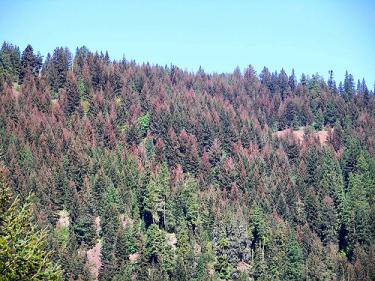When Budworms Attack
The western spruce budworm is the larva of a half-inch-long orangish-brown moth. These voracious caterpillars fatten up on your conifers’ foliage.
What Does It Do to my Trees?
Female moths lay their eggs on the underside of leaves in July or August, then die. The eggs hatch in about 10 days. The caterpillars don't feed right away, but instead spin themselves little tents where they shelter through the winter. They emerge and start eating in May or June.
The caterpillars' main targets are year-old needles and new buds. If they run out of new foliage, they can move on to older growth. They feed on the tree until they reach full size, about an inch to an inch and a quarter long. The caterpillars are hairless. If you see a hairy caterpillar, it's another species.
Once mature, the western spruce budworm larvae spin themselves a pupa of silk and emerge as adult moths about 10 days later, ready to start the process over.
Look for these signs of infestation:
- Chewed-up needles webbed in silk. The caterpillars spin loose webs as they eat. Many other caterpillars make more conspicuous webs, though, so just seeing silk isn’t a guarantee that you have western spruce budworm.
- Lost needles. The caterpillars can completely consume the new foliage, and sometimes eat older needles, too. The trees need those new needles to make sugars to grow on. Without the new foliage, trees are left with brown-looking ends of the branches, where the foliage has been stripped away.
- Branches and crowns of trees die. If the spruce budworm has been feeding for several years on the same trees, the top of the trees may die. Intensive feeding may kill the tree completely. Small trees are more likely to die. Usually, though, western spruce budworm isn’t deadly.
If you've confirmed you have a western spruce budworm outbreak, you have options.
How can I get more tips?
It’s simple! Enter your email below.

